Imperceptible difficulties of rocket technology: Part 5. Launching facilities
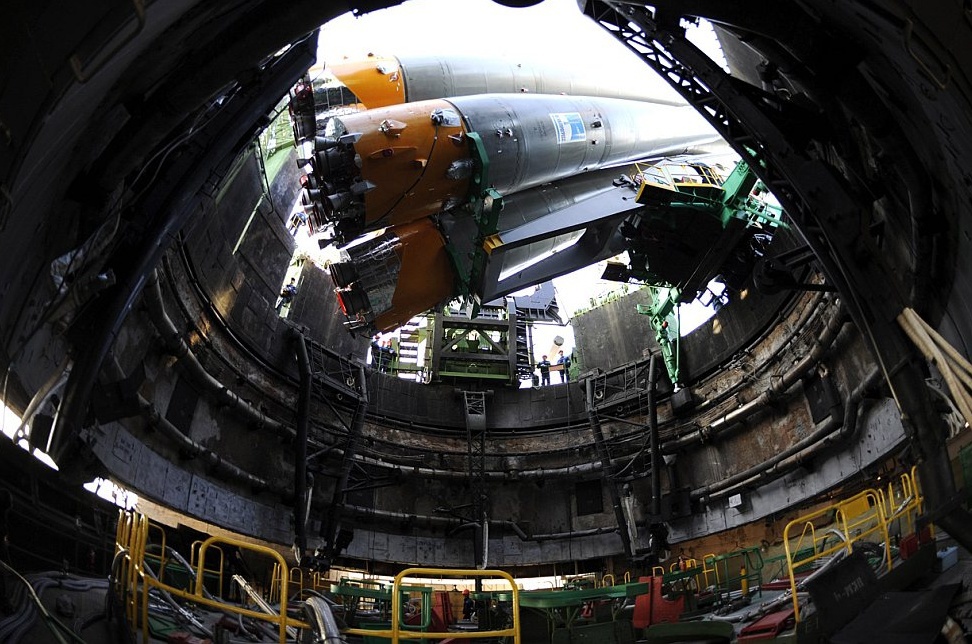
Launch facilities are a separate interesting aspect of space technology. In fact, it is necessary to assemble the rocket, take it out to the launch pad, check again, refuel, land the crew (if the launch is manned) and launch it. And each of the tasks challenges engineering ingenuity, materials science, materials and many other disciplines.
Introduction
In order to make it clear what is at stake, it is necessary to explain the terms used and describe in general how the launch of the carrier rocket occurs.
First of all, the launch vehicle and payload are delivered to the cosmodrome. The booster is almost always delivered unassembled, because it is easier to transport. Then the rocket and the payload are assembled into one unit and checked in a special building, which for various rockets in different countries has many different names: MIC (assembly and test complex), technical position, technical complex, VAB (Vertical Assembly Building, vertical building ), assembly building, etc. Then the launch vehicle, usually assembled together with the payload, is transported to a special site from which the launch takes place. This site also has many names - launch complex, launch pad, launch facility, etc. A rocket, put upright, is a very high thing, so usually there is a so-called. service tower, which allows you to get to the right places on an already installed rocket.
When the rockets were small
The smaller the rocket, the easier the launch complex and less difficulty with it. At the dawn of rocket production, the entire launch complex consisted of a flat concrete platform, a support for a rocket with small legs and an unpretentious service tower:
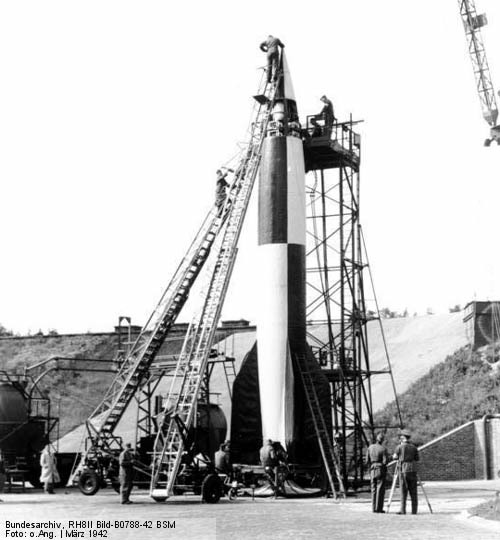
V-2 and ladder.
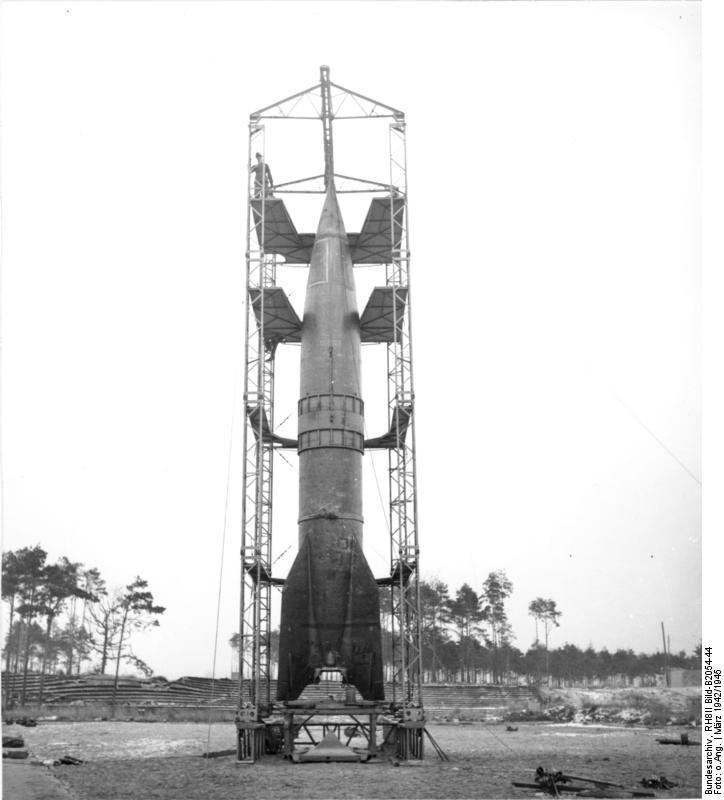
A more advanced version of the service tower. The cone at the bottom is set for uniform emission of gases to the sides.
')
Even on manned launches with launch complexes of small missiles there were no particular difficulties:

1961, the first manned mission of the program "Mercury" - "Mercury-Redstone 3". The tower moves on rails, the technology is similar to a construction crane. Under the starting support the same cone is visible for uniform dispersion of gases.
In principle, for small missiles such an approach is still alive today. A small starting mass means a relatively small engine power and no problems with exhaust gases, a relatively short exposure to high temperature, which reduces the requirements for materials.
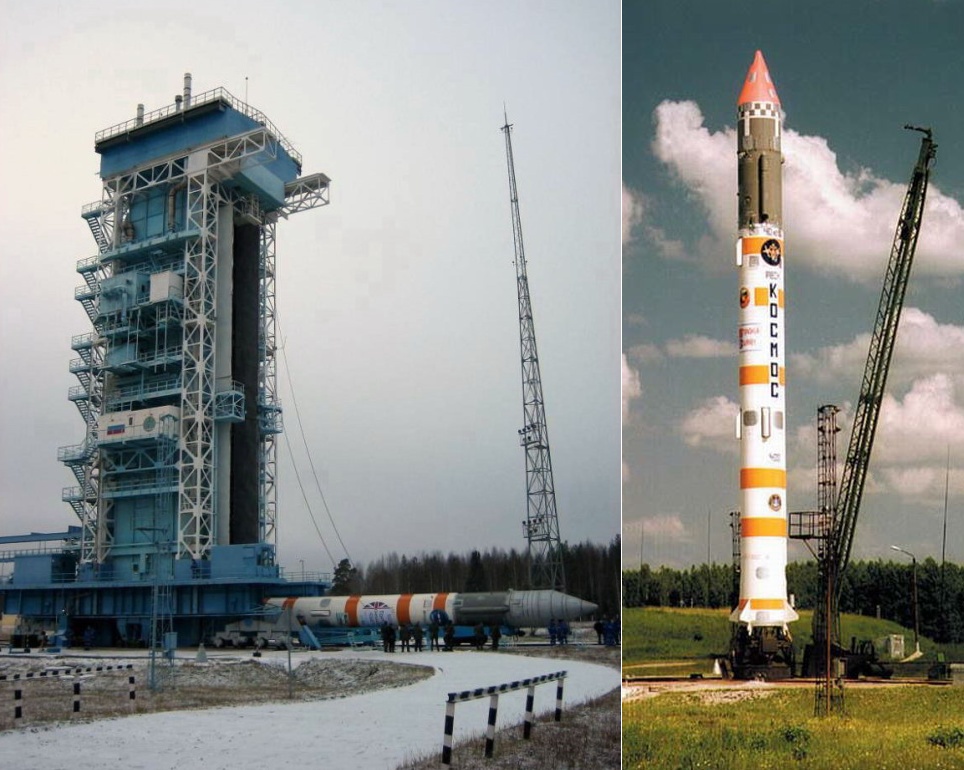
PH "Cosmos-3M", most recently decommissioned. On the left you can see the service tower, on the right - a simple launch pad.
In the West, about the same thing - a small rocket can be put at the start by an industrial truck crane:

Left Taurus, right Minotaur V.
And start up from a higher, but still simple launch facility:
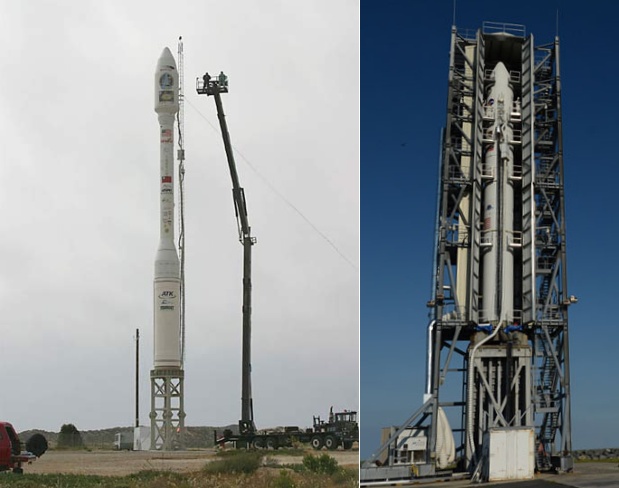
Left Taurus, right Minotaur V.
How the tulip bloomed
Probably the most unusual launch complex is from the R-7 missile family. First, it is the only complex in which the rocket does not stand on the table, but is suspended from the middle. Secondly, in earlier versions, the launch pad rotates entirely before launch. And thirdly, instead of the maintenance tower, two “half-towers” are made, which, moreover, depart from the rocket by turning in a vertical plane. Why were such decisions made?
The decision on the first item is very well described in B.E. Chertok. For rockets of the R-7 family, the first and second stages are assembled in a package. And this package was very poorly installed on the launching table - a serious strengthening of the tail section was required, and this was overweight, and the wind resistance increased. There were even ideas to build a wall around the start. The sketch of the transport device, which took out the rocket and set on four launching pads, one for each side block, did not inspire anyone either. And then there was a very beautiful engineering idea. In flight, the forces of the side blocks are transmitted to the central unit through their upper parts. So why not hang the rocket at the start for the same power units? In this case, the rocket at the start is experiencing the same loads as in flight, and no special measures are needed to strengthen the structure. A rocket immersion inside the launch facility solves problems with wind load.
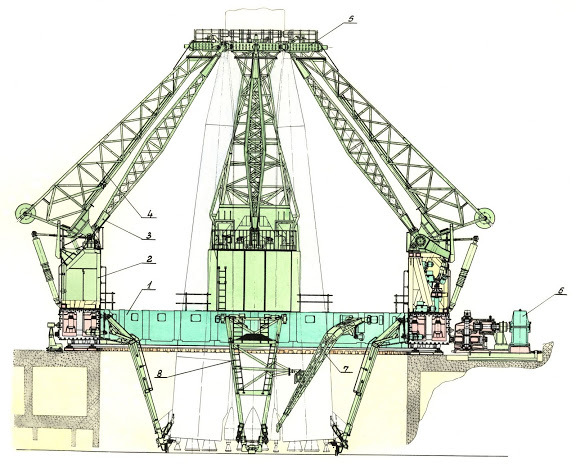
Scheme starting table. At the very bottom there is also a sliding table for staff access, not shown here.
Point two was based on the task of facilitating the work of the control system. At that time, deploying a rocket together with the launch pad before launch was easier than setting up a U-turn after launch for an analog control system. Now, in the age of computers, this is an anachronism. At Baikonur, the tables are able to turn around, and this is used as inherited, and on the new launch complexes (Kura, Vostochny), the tables are already without turning devices.
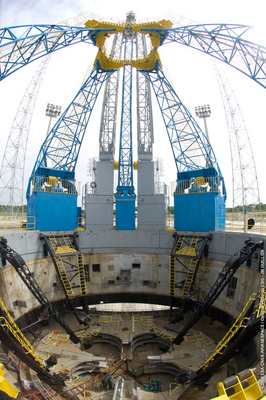
Photo of the launch facility in Kourou.
The third point is due to the constant upgrades of the R-7 family of missiles. At first there was a simple one-tier platform:

When R-7 became Vostok, a mobile service tower was added to the single-level platform:
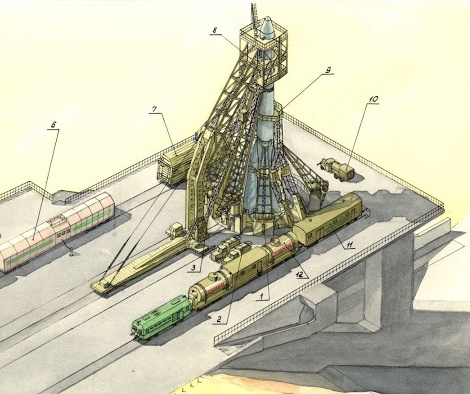
For "Sunrises" and "Lightning" have added levels:
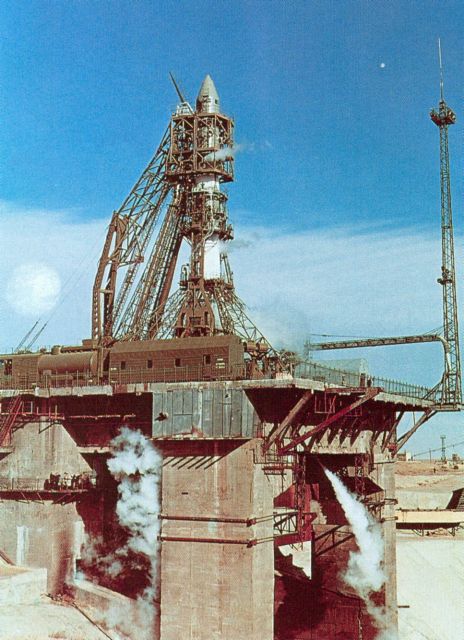
The result is a bit predictable :)

This is Plesetsk, here are 9 levels, at Baikonur 8.
Big picture, very beautiful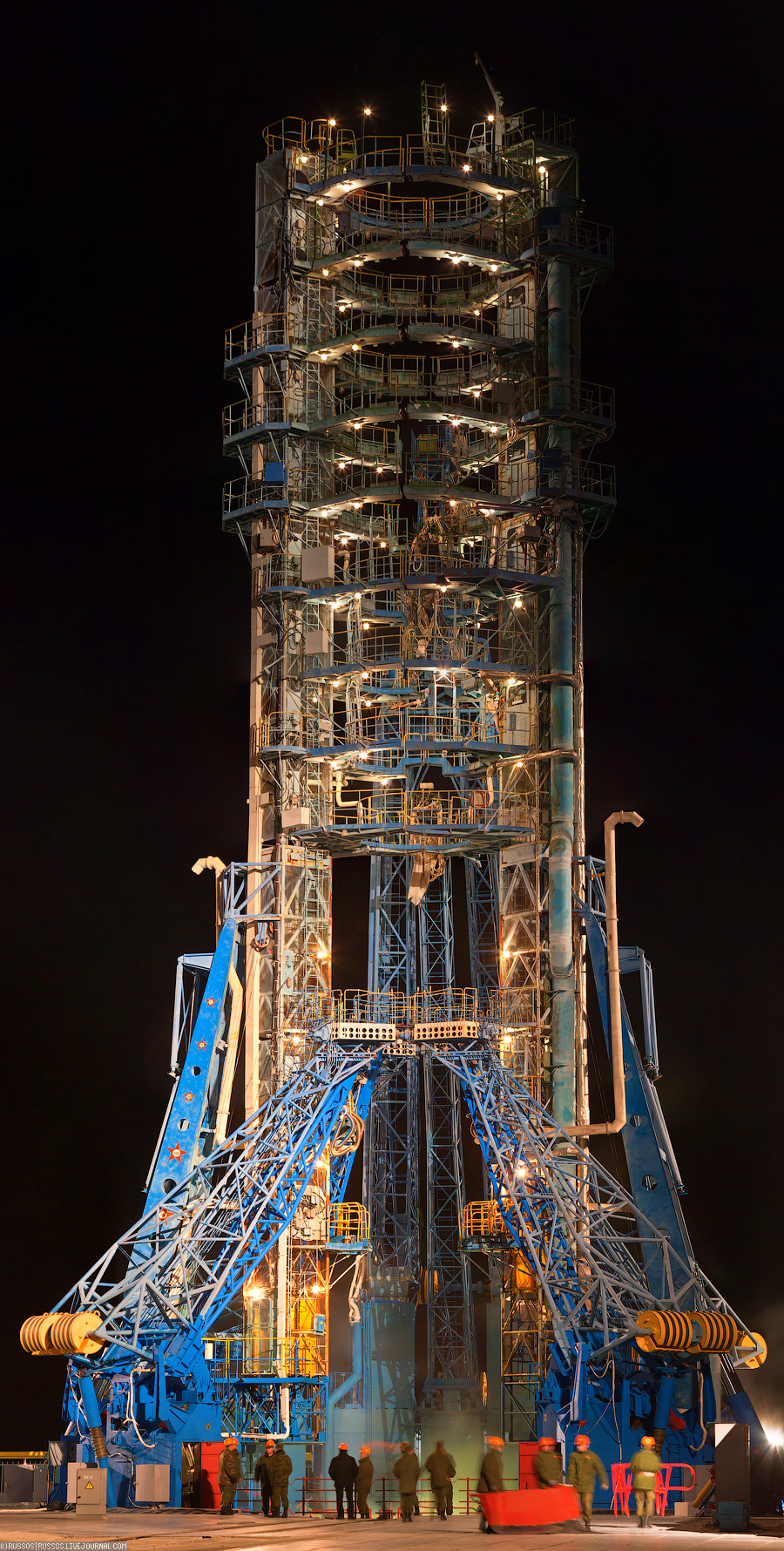

Despite the beautiful view, the structure is not very comfortable. The grounds are open, blown with all the winds, and work in frost or heat is the inconspicuous heroism of starting calculations. Therefore, when they began to build the start of the "unions" in Kourou, they designed the usual mobile tower (there was another factor, it will be a little later):

The good result of the operation of the new tower led to the fact that the "East" will be the same.
Guns for battle ride backwards
A separate interesting dilemma is the transportation of the rocket to the launch. And, of course, there are many possible solutions, with their pros and cons. First of all, the rocket assembly can not be taken anywhere at all - to assemble right at the start, to check and to launch. Secondly, the rocket can be assembled horizontally, taken to the launch, installed vertically, and fired. Thirdly, the rocket can be assembled vertically, and taken to the launch immediately in a vertical position. And you can also mix these options.
The first option is implemented mainly for small rockets (because it is simple):

Taurus again. At the left, covered with blue, the first step.
Also experimented with this option, suddenly, the Indians. The PSLV rocket was assembled immediately on the launch pad .
Advantages:
- No need to carry a rocket to the launch.
Disadvantages:
- It is necessary to take away the assembly and test complex from the start.
It is clear that with the increasing size of the rocket, the MIC becomes harder to carry than a rocket.
Option two is the Soviet / Russian school, as well as SpaceX. "Unions", "Protons", "Cosmos", "H-1", "Energy", "Zenith" and "Falcons" are going to start in a horizontal position. The transporter is also an installer, and it rotates the rocket.
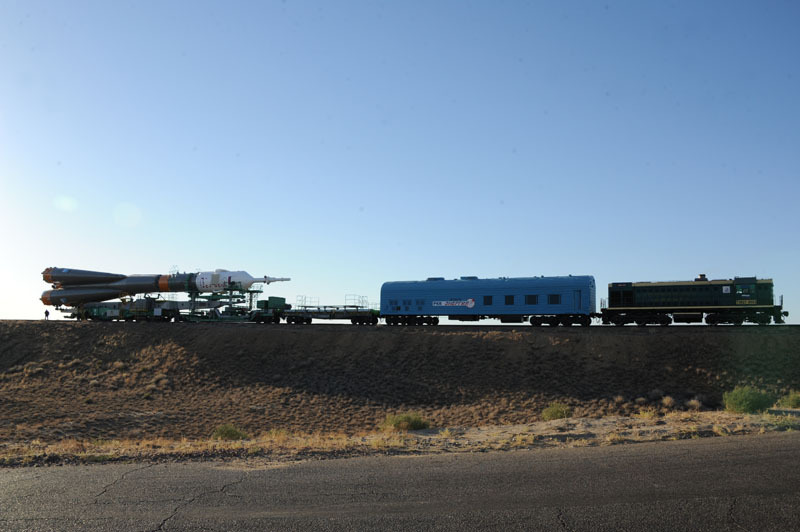
Advantages:
- A long MIC is easier to build than a tall one.
- Carry in a horizontal position easier.
Disadvantages:
- Additional bending strength is required from the rocket and payload.
Option three is the US school. Then they were joined by India, China, Europe.
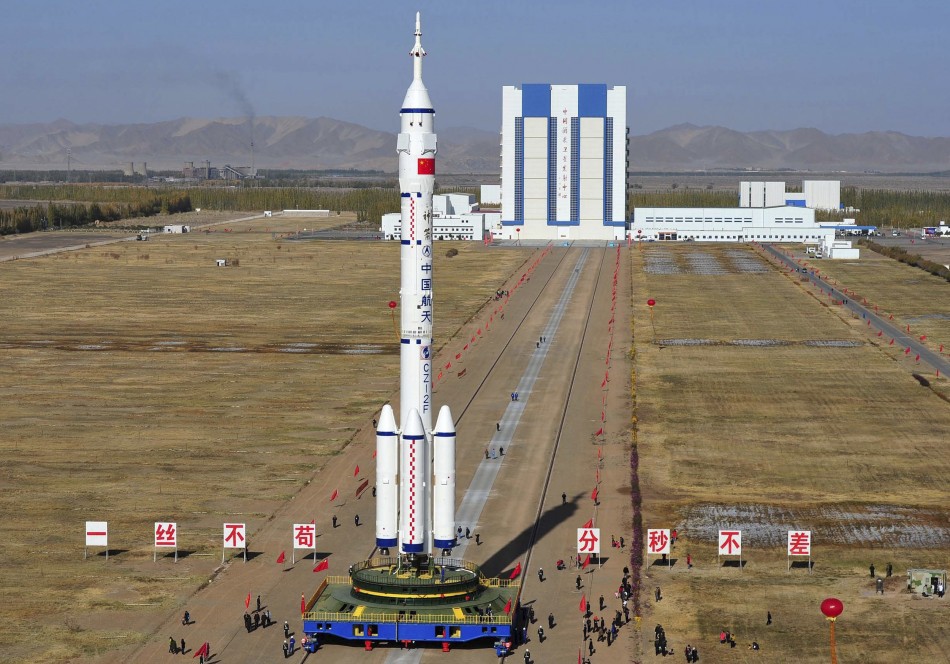
"The Great March", piloted version, China.
Advantages:
- On the rocket and the payload force acts only in the direction of "up-down".
- No need for installer and verticalization procedure.
Disadvantages:
- Need a high mic.
- Somewhat more complicated transportation.
The fourth option is the Kourou space center. The fact is that European satellites are often simply not designed to be transported in a horizontal position. To save weight, they are devoid of bending strength. But what if the Soyuz is designed for horizontal transportation? We decided to make a hybrid method - the first three steps go as usual, horizontally, and the payload with the accelerating unit is set at the start. This is the second reason for creating a mobile service tower.

Advantages:
- Combines the convenience of horizontal transportation and vertical assembly.
Disadvantages:
- Requires a clean room, a mini-MIC in the service tower.
Tower dilemma
The next question is - is a service tower needed at all? Let us carry out all checks in MIK, and start up operations with automatic. In this case, no one and no reason will have to walk around the service tower, and it will not need to be built at all. The idea is attractive, but as it turned out, it also has its drawbacks. She was the first to be sold in the USSR for the Zenit rocket. The process of installation, refueling, preparation for start-up and start-up was fully automated and did not require a person to do anything but work with his head and pressing buttons. The start was simple and minimalistic:

All is good, but such a start, firstly, is unsuitable for manned launches. For the same "Zenith", which decided to make manned, had to build a "birdhouse" service tower:

The second drawback is that nothing can be fixed at the start. If there is a minor failure, which, if there is a turret, could be corrected in half an hour, the rocket has to be removed from the launch and taken back to the MIC. The tower is also absent from SpaceX, and those who follow the launches of the Falcons probably noticed that launches are regularly postponed to a later date. Of course, faults are different, and not everything can be fixed on the spot, but the presence of the tower makes it possible to correct minor failures quickly.
Tower Dilemma 2
Another question, again associated with the tower - is a question of its mobility. Is it necessary and reasonable to spend money so that the tower can move off from the start? Here are guided by engineering expediency. A fixed tower must withstand a rocket blast at the start. The mobile should have motors, wheels and rails, as well as a system for stretching and gathering communications and pipelines. What is easier, cheaper and more familiar, they do. There are no national schools here, in each project the engineers make it more comfortable. For example, for the "Proton" made a mobile tower:
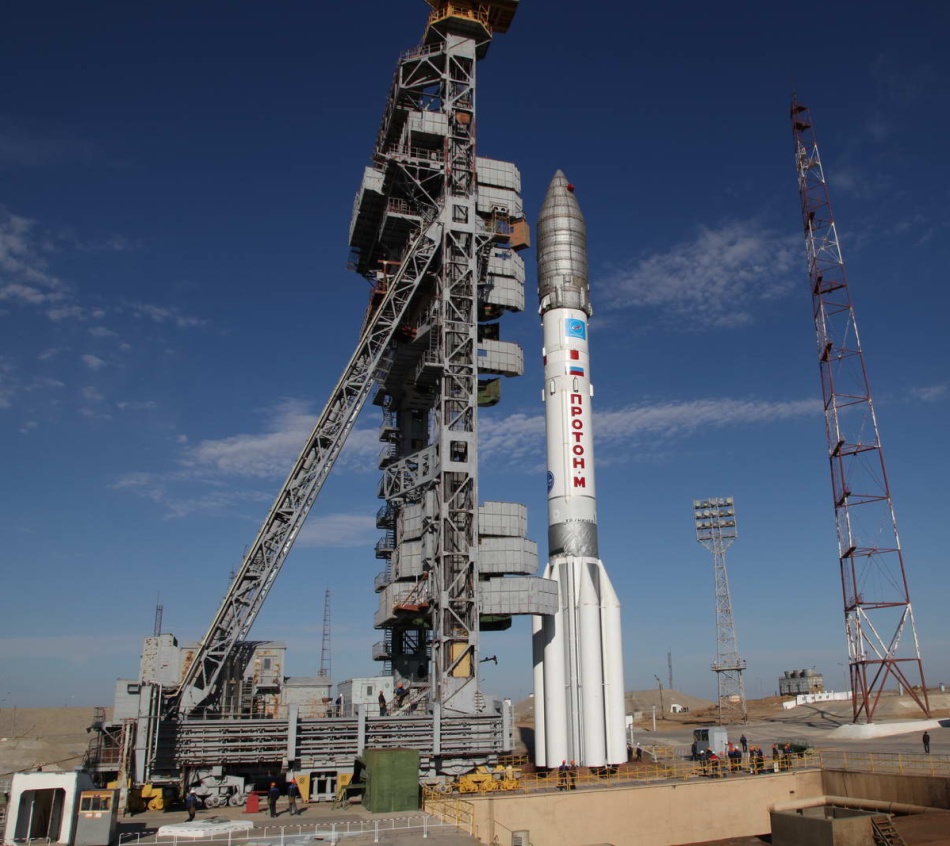
Panorama of the launch complex, view from the very top of the service tower.
And for the "Angara" - is already stationary:
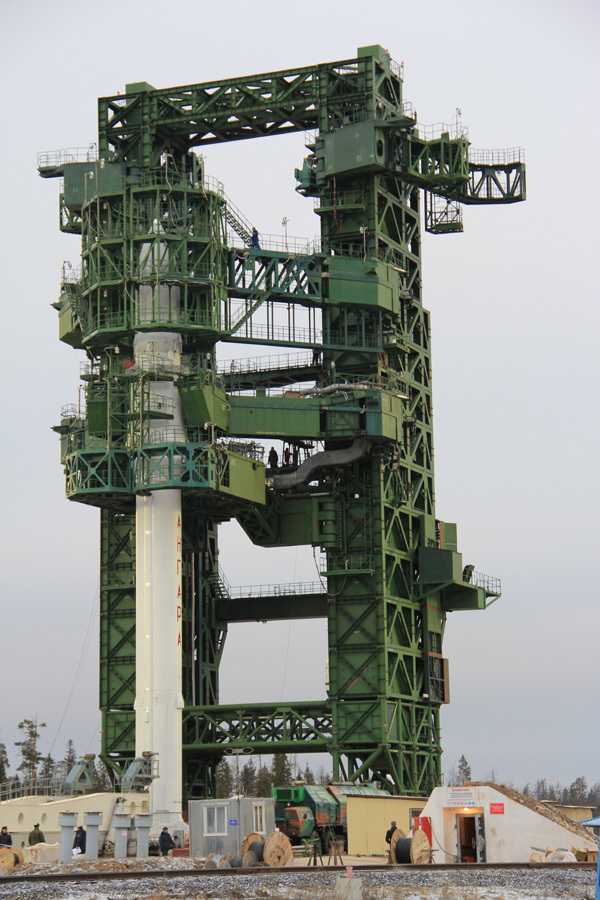
Throne of Gulliver
You can not ignore the launch complexes for superheavy missiles. The size and complexity of these systems, as well as the technical solutions chosen, are simply astounding.
Americans acted in the tradition of their school - vertical assembly and transportation. A key element was the tractor carrier, which drove the rocket along with part of the launch pad and service tower. This is less known, but there was still the second half of the tower, which was driven by the same tractor:
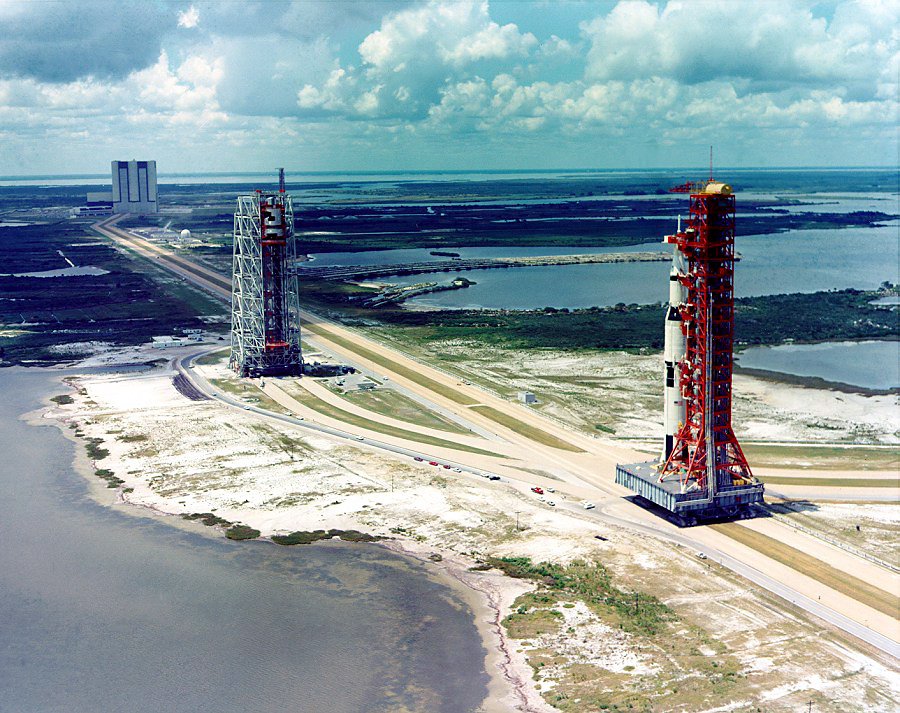
"Saturn-V" with the top of the launch pad and one maintenance tower going to the start. The second tower is waiting for its turn in the "dead end" of the road for the tractor. In the distance you can see the building of vertical assembly.
A little engineering oddity. The Apollo missions to Skylab and the Soyuz-Apollo mission used the same launch complex LC39, but a smaller rocket, the Saturn-IB. In order for the rocket to stand in front of the same masts on a much larger launch facility, a “high chair” was made — a truss structure that raised the rocket to the height of Saturn-V:
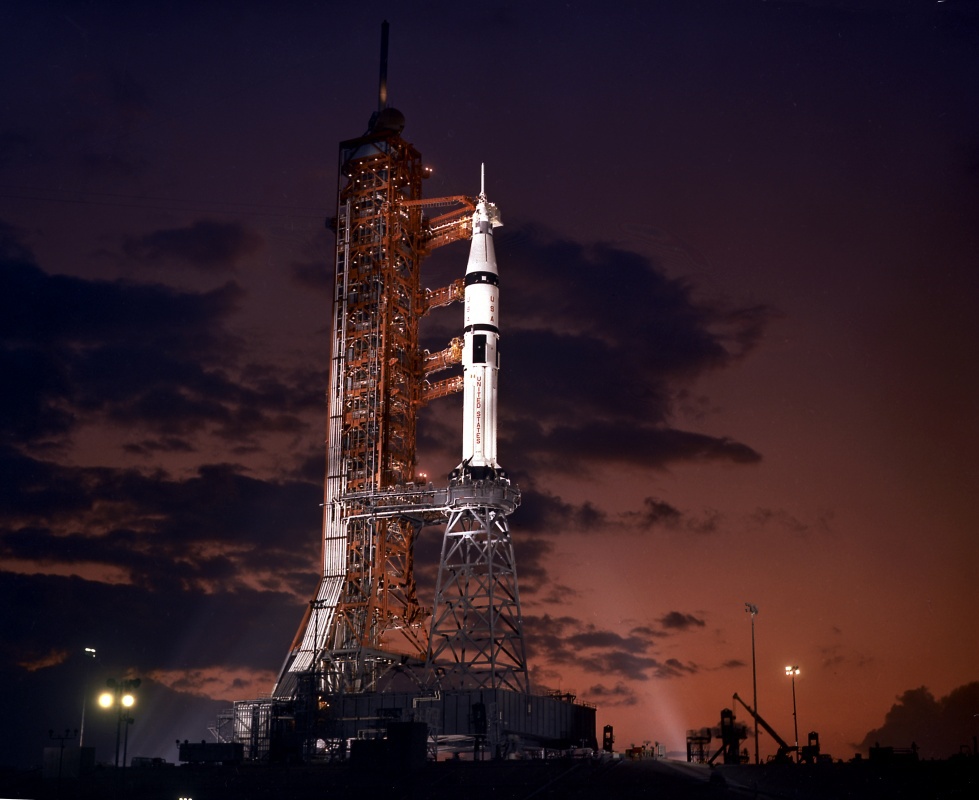
The Soviet H-1 rocket was also made in native traditions; it was carried in a horizontal position on a giant installer by two diesel locomotives along parallel rails. Is that the service tower was somewhat unusual - quite small.

With the beginning of the development of reusable ships, the launch complexes were waiting for the same fate - they were converted to reusable ships on both sides of the ocean.
In the USA, a very elegant service tower was made with a turning point:
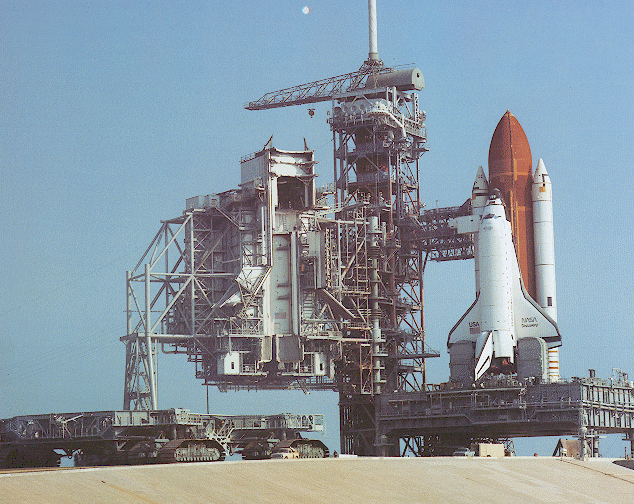
In the USSR, a complex of two towers was made nearby:

Large pipes on the left tower - the system of landing and emergency evacuation of the crew. Photos from the site Buran.ru, copyright had to be cut off when cropping.
Gas pipelines
If you carefully looked at the surface under the starting table in the photographs, you probably noticed the tunnels, apertures, and recesses. These are gas breeders, they are needed for the discharge of gases emitted by a rocket. For powerful engines of heavy rockets a simple cone under the bottom is no longer enough. Their design can be different, in the United States more often used a bulk launch table with irrigated gas pipelines at ground level. Water softens the shock wave and reduces the temperature load on the walls. Our gas breeders are usually dry and located below ground level. The April launch of “Falcon'a” showed that in case of using irrigated underground gas ducts it is worth monitoring the level of fluid in them - the rocket launched through a mud fountain, it’s good that it didn’t cause any problems.
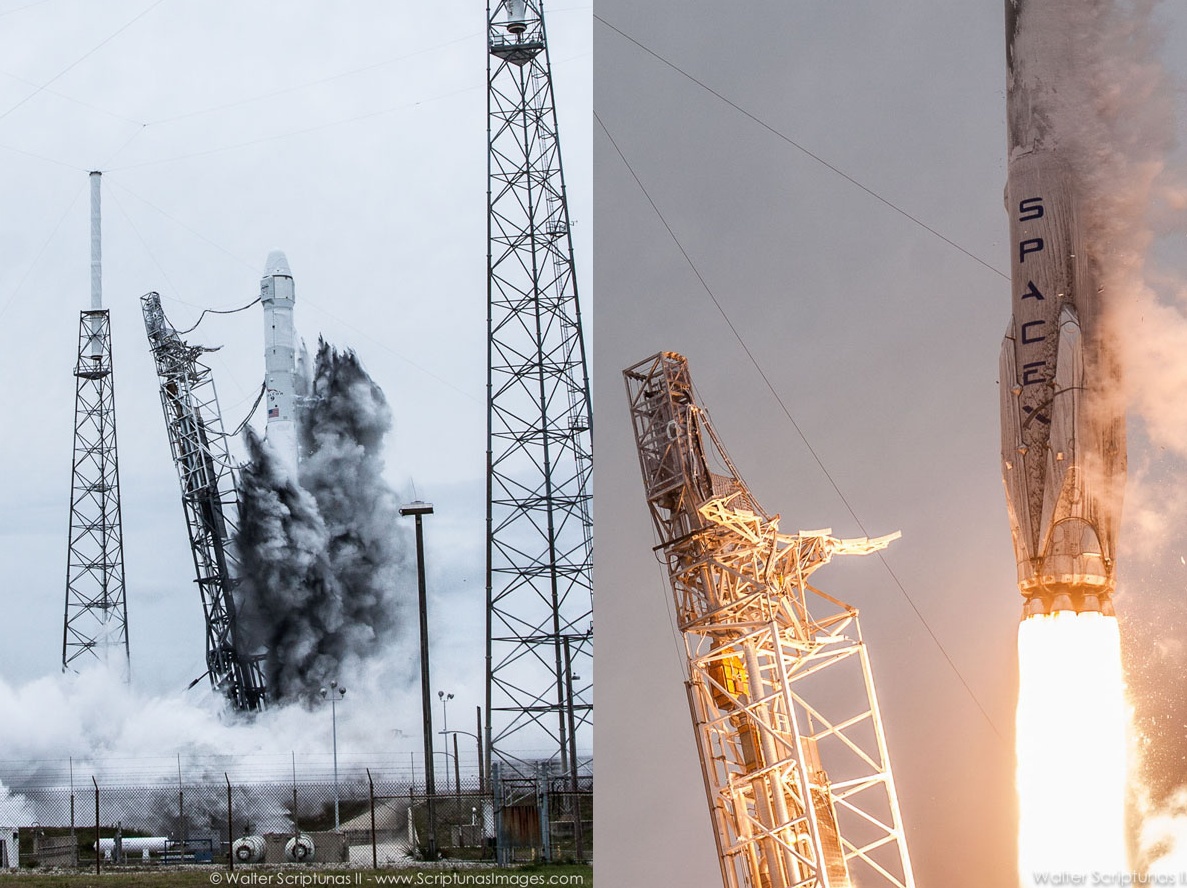
Conclusion
In conclusion, a beautiful slow-motion video of Zenit at Sea Launch. The work of the starting mechanisms and the evaporation of falling ice are visible.
For navigation
This is the fifth post of the cycle. Direct links to the previous ones:
- The first post.
- Solid fuel engines.
- Types of liquid fuels, geometrical dimensions, transportation.
- Schemes of engines and insides of tanks.
Sources
- TSENKI. Starting and technical complexes.
- KIK of the USSR - unique photos.
- Panoramas of the site FKA Roscosmos.
- Special thanks for the gorgeous photos at loveopium.ru and for the blogger russos .
Source: https://habr.com/ru/post/220977/
All Articles